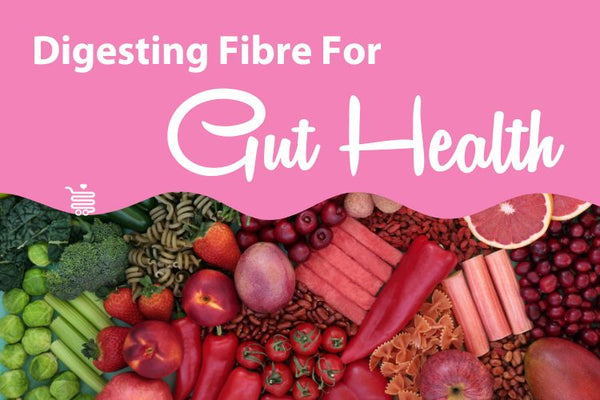- Ph: +61 435 003 412
- operations@fodshopper.com.au
"Organic Orange" has been added to your cart. View cart
"Organic Orange" has been added to your cart. View cart

Written by Shaynie Ashkenazi BSc. MHumNutr., FodShop Founder & Registered Associate Nutritionist
Getting enough dietary fibre into your daily diet is essential for normal functioning of the gastrointestinal system. It has also shown to reduce risk of a number of chronic diseases including diabetes, heart disease, and certain cancers.
The topic of dietary fibre is a complex one, as there are many different types of dietary fibres, all of which work differently in the human body, thereby conferring a vast range of health benefits.
Generally speaking, dietary fibre cannot be completely broken down by human digestive enzymes.
Soluble fibre is a type of fibre which dissolves in water to form a gel-like substances, helping to lower blood glucose and blood cholesterol levels.
Insoluble fibre comprises indigestible carbohydrate that is unable to dissolve in water. Insoluble fibre adds bulk to our stools, helping make them easier to pass.
Dietary prebiotic fibres are important for gut health as they nourish the resident good bacteria, naturally present in the gut.
Prebiotics promote the growth of, and boost increased numbers of, friendly bacteria i.e. they are "bifidogenic".
Some research has also shown that prebiotic fibres may help with various digestive problems, and even boost the immune system. Prebiotic foods have also been shown to improve metabolic health and even help prevent certain diseases.
Prebiotic fibres are naturally found in the below foods:
If you have IBS and follow a low FODMAP diet, however, you'll notice that most of the above-mentioned prebiotic fibre-rich foods are actually high FODMAP!
If you are following a low FODMAP diet, your Accredited Practising Dietitian may have advised that you consume more dietary fibre to help meet your nutrition requirements and/or assist in managing IBS symptoms of constipation and/or diarrhoea.
Including low FODMAP varieties of dietary fibre, including oats, semi-ripened banana, cooked-then-cooled potato (potato salad), and cooked then re-heated gluten free pasta may be a sensible option to get more fibre in, without risking triggering IBS symptoms.
The national recommended fibre target for Australian adults is 30g per day.
Most individuals struggle to get this amount of fibre into their diets each day, making the idea of fibre supplementation an attractive one to help meet the daily target.
If you have IBS, choosing the right fibre can be challenging as most prebiotic fibre supplements commercially available in pharmacies, supermarkets & other independent health food stores contain inulin and wheat dextrin. The quick fermentation of these fibres in the gut can cause gas & bloating.
Psyllium husk is a good low FODMAP soluble fibre option, as it may improve constipation and diarrhoea i.e. regulate the stool, while also assisting with glycaemic control & satiety.
Some individuals, however, complain that this supplement is grainy and does not mix well with liquids; a major barrier to consumption during daily activities.
Sunfiber is a soluble prebiotic fibre that is unique compared to other non-galactomannan based fibres (locust bean gum, fenugreek, guar gum etc..).
When fermented in the gut, prebiotic fibres produce “short chain fatty acids” (SCFA). The rate of production of SCFAs is very important, because if fermentation occurs rapidly i.e. in the case of inulin, chicory root and other high FODMAP soluble fibres, the result is excess flatulence & bloating.
The fermentation process that Sunfiber undergoes in the gut is extremely slow, resulting in a higher total amount of SCFAs that are produced over a longer period of time, leading to much less bloating, gas, and discomfort.
Lockyer & Stanner (2016). Dietary fibre and the prevention of chronic disease – should health professionals be doing more to raise awareness? Volume 41, Issue 3, Pages 214-231 https://doi.org/10.1111/nbu.12212
Nutrient References Values Australia New Zealand (2019). Dietary Fibre. https://www.nrv.gov.au/nutrients/dietary-fibre
Pham VT, Seifert N, Richard N, Raederstorff D, Steinert RE, Prudence K, Mohajeri MH. 2018. The effects of fermentation products of prebiotic fibres on gut barrier and immune functions in vitro. PeerJ 6:e5288 https://doi.org/10.7717/peerj.5288
bifidogenic , dietary fibre , Dietitians , FODMAP , FODMAP diet , FODMAP dietitian , FODMAP expert , FODMAP food list , FODMAP foods , FODMAP Friendly , FODMAP Friendly Foods , FODMAP Learning , FODMAP Recipes , FODMAP Stacking , Fructose friendly , gut health , High fibre , IBS , ibs det , IBS diet , IBS friendly recipes , insoluble fibre , Low FODMAP , low FODMAP diet , low FODMAP food list , Low FODMAP Foods , Low FODMAP learning , Low FODMAP Recipes , Microbiome , Monash FODMAP , Monash FODMAP App , prebiotic fibre , Prebiotics , probiotics , Regular Girl , Regular Girl Australia , soluble fibre , Sunfiber , Sunfiber Australia , Taiyo Sunfiber , Tomorrow's Nutrition

st started taking it. Thanks. Read LessRead less about I ordered my sunfibre a 13th March and
e wins. The flavours are also really nice and don’t have a ‘pre-made’ taste to them. Read LessRead less about I can’t eat garlic or onion, so a lot
Comments
I was skeptical, but this weight loss product has proven itself beyond doubt. From 95kg to a stunning 60kg, it’s a true game-changer. click here to discover the power of this amazing solution!
I had tried everything to lose weight, but this product was the key to my success. It helped me drop from 100kg to a stunning 65kg. Say goodbye to stubborn fat and hello to a healthier, happier you. click here to get started!
From 85kg to 55kg – this weight loss product is the secret to my success. It has truly transformed my life. click here to discover the power of this life-changing solution!
Losing weight is now within reach, thanks to this amazing product. From 85kg to a lean 55kg, the results speak for themselves. Take control of your weight and click here to experience the benefits firsthand!
Your article presents a balanced view by considering both the advantages and disadvantages of the topic. If you’re interested in exploring more pros and cons, click here for a detailed analysis.
Leave a reply